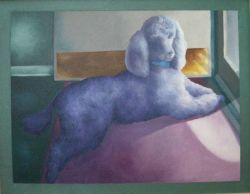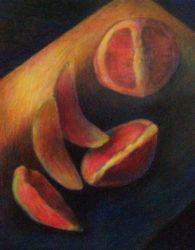Find Good Art Lessons

"Charley"
Oil Painting
by Lois DeWitt

"Grapefruit"
Colored pencil drawing
by Lois DeWitt
I personally feel that the best high quality, information-rich art instruction is here on Free Online Art Classes.com!
So, I would suggest exploring the lessons and resources on this website, then searching other art instruction websites to see what they offer. Comparing a variety of websites will help you decide what you want to learn and what kind of instruction suits you. Above all, I think that if you are interested in art or learning art skills and techniques, what ever website you find should spark your interest, fire your imagination and encourage you to progress creatively.
And, do consider art classes that you can actually attend! As wonderful as the Internet is, as an art instructor, I believe nothing can match the one-on-one realtime contact between student and teacher!
Below is my Ezine article with guidelines to help you select the best art instruction option. If you click here you will see ALL of my Ezine Articles on a variety of art topics! I wrote this article to give people some guidelines as to what to look for in art instruction. If you are not familiar with art skills and techniques, free online lessons give you a chance to try your hand at creative activity without making a financial commitment.
How To Find Good Art Lessons That Are Right For You
There are many art instruction websites that you have to pay for to get art lessons. Are they any better? Not necessarily. You should be able to preview the art instruction you will receive, especially if you are paying for it.
If the website promises to make you an artist and/or give you a certificate for your completion of the instruction, think twice. A certificate from an online instructional source is pretty much useless apart from giving you a brief ego-trip and false assurance that your artistic skills are recognized (by whom?)
Keep in mind that art is self-evident, and if you have not achieved a degree of creative and artistic skills, a certificate will certainly not aid in enhancing your ability.
There are many art instruction on the Internet these days. Some are informative and even inspiring. Others do not adequately cover the content or you may find it difficult to follow the instructions. Some have way too many ads you have to click through them to find the certain subject or lessons you want. Others are simplistic, dumbing down the instruction, offering very little information and leaving the student feeling cheated or bored.
Some Helpful Guidelines...
Where some art instruction websites offer many areas of study, for example, painting, drawing, sculpture and printmaking, other may offer just one area, drawing, for example. The variety of subjects presented doesn't necessary assure the quality of the website. But, how can you tell a good art learning website from a bad one, especially when you are not that familiar with the subjects to begin with?
Here is a check list that will help you choose a good website--one that will be easily understandable and present a rewarding learning experience for you.
* Does the website offer what it says it does? Believe it or not, quite a few don't. For instance, if they say they offer free lessons, are the lessons actually free of charge or is there a hidden "enrollment fee" or some other kind of charge for accessing the information.
* Can you easily find the lessons you want to take, or do you have to click through several ads or links to do so? Often the content of the lessons in this kind of website is lacking in quality because the website is simply a tool for monetizing.
* Is the instruction information-rich, presented clearly and in a step by step format? Many websites offer a bulk of information that is hard to follow and leaves the student confused as to the next learning step. You want to be able to easily follow the instruction and be given the opportunity to thoroughly understand the specific information before moving on to the next step. It is no help to you if the instruction assumes you know a certain area of study and passes over it, leaving you with many unanswered questions.
* Are there pictures or videos that show you specific processes, techniques as well as examples of work for that particular area of study? There are several websites that offer lessons with absolutely no visual references at all. For the visual arts, this is like offering a cooking course without having access to a working kitchen!
* Is there a facility that offers interaction with the website instructor(s)? Can you contact a real teacher by email or phone if you have a question concerning your learning process. AND, can you submit pictures of your artwork in progress for a critique?
* Be cautious about "How To Draw A---" websites. Why? Because although a website may offer clear, concise instruction on how to draw a nose or an ear, this is a "quick and dirty" approach to the skill of drawing. Where, indeed, you may learn how to draw a nose, you will eventually want to draw a mouth, eyes, lips, etc. A quality art instruction website can teach you basic drawing skills which will enable you to draw anything. The "how to draw a nose" approach is similar to "How To Build A Shed" by showing you how to nail two boards together.
* Good artists are not necessarily good instructors. Websites that show the beautiful work of an artist and then offer their instruction either via e-books, online subscriptions or workshops imply that in no time at all you will be able to paint like they do. This approach is similar to the diet that is touted by the slim and beautiful young woman talking about how easily and quickly she lost thirty pounds! Look for testimonials from students who have taken lessons from the artist/instructor. Look for examples of student work, especially if you are paying tuition.
* Does the website offer a package of art materials specific to each course? Or, does the website define specifically what you will need for your lessons prior to instruction? In art, this is very important. Poor materials perform poorly and often, the visual effects you are trying to achieve, cannot be a achieved with poor quality or simply the wrong materials and media. Art is a close dialogue between the eye, the hand and the materials. You bring into the instruction your fine pair of eyes and eager hands. It is the instructor's responsibility to provide clear and concise information on what materials you will need for each lesson.
* On the other side, carefully examine the curriculum of a website that offers elaborate packages of art materials, for example, lovely polished wooden boxes of oil paints, extremely expensive brushes and canvases, etc. Compare what they are asking you to purchase with similar materials offered by your local art supply store, or reputable online art supply houses.
* Question any kind of "certificate or degree" that states that you are now an accredited artist or skilled in a certain field of study, especially if you have paid for your instruction. Although your accomplishment is worthy and should make you feel good, art learning, like any other area of study, should not be limited by assumed expertise. There is always a need to improve your skills and develop new ones towards your journey towards becoming proficient as an artist.
* Lastly, look for a mode of instruction that is compatible with your personality. Students who are aligned with their instructor learned better; more quickly and easily. And an instructor should be one that you admire, who inspires you and councils you every step of the way The art learning experience is, above all, a joyful and inspiring one!
Real Feedback
...I currently I'm working with a author for children's books and I'm doing some of the illustration. This has been a real challenge, but enjoying it. When I not at home my sketch pad goes with me and I'm practice on something all the time. I've taken my art more serious and have the time to do what I thought I would never be able to do and you have inspired me to make me realize a dream that I thought I wouldn't get to do in my life time. Will be sending a picture for you to look at and see where I need to do to improve. It may take a week or two, but you will hear from me. Janice
-----
I'm 60 and just getting back into art. My mother was an artist and I always wanted to be one too. I like the (acrylic) painting and I'm just finishing up the Intermediate! Never though I could paint so good! Eleanor Fuller
-----
Please send link to basic drawing lessons--enjoyed your blot painting! Thank you, Phyllis
-----
Hello Lois....In your introductory e-mail you asked about who I am. I'm retired. As I watched my triplet grandchildren drawing and creating fine looking artwork, I got to thinking about how much I had enjoyed drawing when I was about their age. My recollection is that I was pretty good but in truth probably not as good as my aging memory recalls. I do know, though, that I enjoyed it very much. So one day I sat down with paper and pencil to sketch a masterpiece only to find that all the talent I had as a teenager had been lost somewhere on my journey to senior citizenship. The desire, if not the ability, was there so I began searching the net for drawing lessons. I was surprised to find sites that actually provided free lessons. (I fully expected to pay for lessons) I was most impressed with your site so here I am....hoping to reawaken a long suppressed interest in the art of drawing.
Darrell Larson
-----
It's never to late to do art! I've been painting with water color and then did some little cards for my twelve year old niece.
Thank you for your art lessons,
Betty Jacobsen
Notes on Writing The Artist Within Lessons...
Five years ago, for a small business course at a community college I developed a financial plan for "The Artful Life Program," a series of art learning classes for 55+ students.
This offering of art classes could be installed in a community recreation center, a church basement, an instructor's house, or wherever people wanting to learn and do art could congregate.
I had to do the financials, figure out what would be needed to teach in a facility and project an income and expense sheet for its operation.
I came a way from the small business class with a good working plan for bringing art to the 55+ community. One of the classes I called "Finding The Artist Within." Based on my experience with teaching older people, the course was constructed to refresh, inspire and develop creative skills through a series of exercises. I made each project simple, fun and provocative and directed towards an end goal of helping the students choose an artful direction in painting, drawing, printmaking, or collage.
Through six lessons, students could develop their imaginative, visualizing and creative skills will working on projects that were fun for the group and not intimidating.
Over the years, I have taught "Finding The Artist Within," in in private classes as well as life-long learning programs. It remains today, one of the most popular class offerings I have!